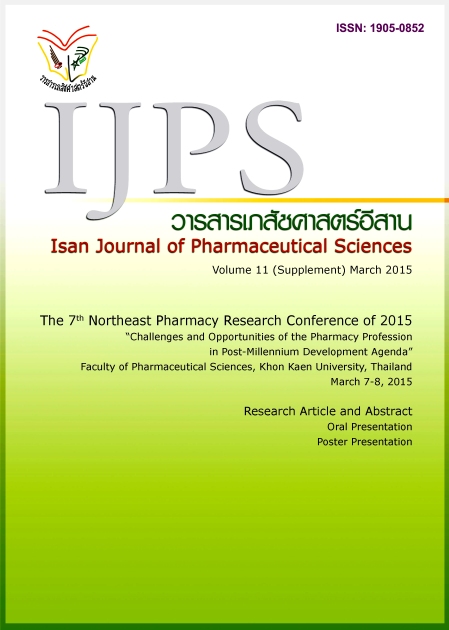Complying with Control Measure for Antimicrobial Prescribing in Hospital
Main Article Content
Abstract
Introduction: Control measure for antimicrobial prescribing in the hospital was a way to support the rational drug use. Objective: This study was aimed to assess the complying to control measure for antimicrobial prescribing in the hospital. Materials and methods: Data were collected from antimicrobial order form of 5 antimicrobials and patient medical record of hospitalized patients during July to September 2013. Results: There were 422 prescribing in 343 patients, but only 355 prescribing were recruited into the study. Meropenem, vancomycin, piperacillin/tazobactam, imipenem and cefopereazone/sulbactam were prescribed 31.0%, 26.5%, 18.6%, 18.3% and 5.6%, respectively. Complete record was found in all items in 117 forms (33.0%). Most common incomplete item was culture report (41.4%) followed by reason for prescribing over 4 d (16.9%) and gram stain (15.8%). Information was consistent in all items in 56 prescribing (15.8%). Most common inconsistent item was duration of drug use (18.8%), followed by pattern of use (7.3%) and type of infection (6.8%). Conclusion: Prescribing of target antimicrobial was complied with the hospital control measure for antimicrobial prescribing but most of data were incomplete and inconsistent.
Article Details
In the case that some parts are used by others The author must Confirm that obtaining permission to use some of the original authors. And must attach evidence That the permission has been included
References
Ayuthya SK, Matangkasombut OP, Sirinavin S, Malathum K, Sathapatayavongs B. Utilization of restricted antibiotics in a university hospital in Thailand. Southeast Asian J Trop Med Public Health 2003; 34: 179-86.
Dejsirilert S. Current situation of antimicrobial resistance surveillance in human in Thailand. J Health Systems Res 2012; 6: 306-9.
Institute of Hospital Quality Improvement and Accreditation. Hospital and Health Care Standard. 60th Anniversary Cerebrations of His Majesty’s Accession to the Throne Edition. Bangkok: The Institute of Hospital Quality Improvement and Accreditation; 2006.
Hogerzeil HV. Promoting rationale prescribing: an internation perspective. Br J Clin Pharmacol 1995; 39: 1-6.
Management Sciences for Health and World Health Organization (MSH and WHO). Managing Drug Supply. West Hartford, CT: Kumarian Press; 1997.
National Health Security Office. Service quality criteria and assessment guideline budget year 2011 [Online]. 2010 Oct 1 [cited 2015 Feb 5]. Available from: http://www.nhso.go.th/downloadfile/fund/คู่มือบริหารงบคุณภาพ.pdf.
Pumart P, Phodha T, Thamlikitkul V, Riewpaiboon A, Prakongsai P, Limwattananon S. Health and economic impacts of antimicrobial resistance in Thailand. J Health Systems Res 2012; 6: 352-60.
Sirinavin S, Suvanakoot P, Sathapatayavongs B, Malatham K. Effect of antimicrobial order form guiding rational use of expensive drugs on cost containment. Southeast Asian J Trop Med Public Health 1998; 29: 636-42.
Yamane, Taro. Statistics, an Introductory Analysis, 2nded. New York: Harper and Row; 1967.


